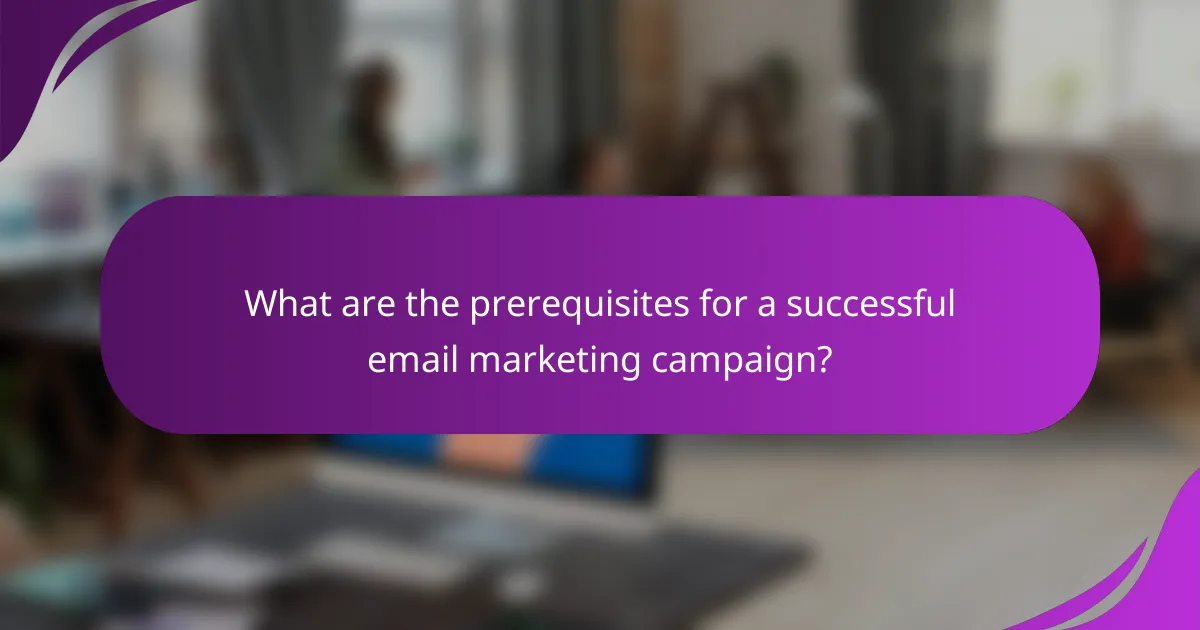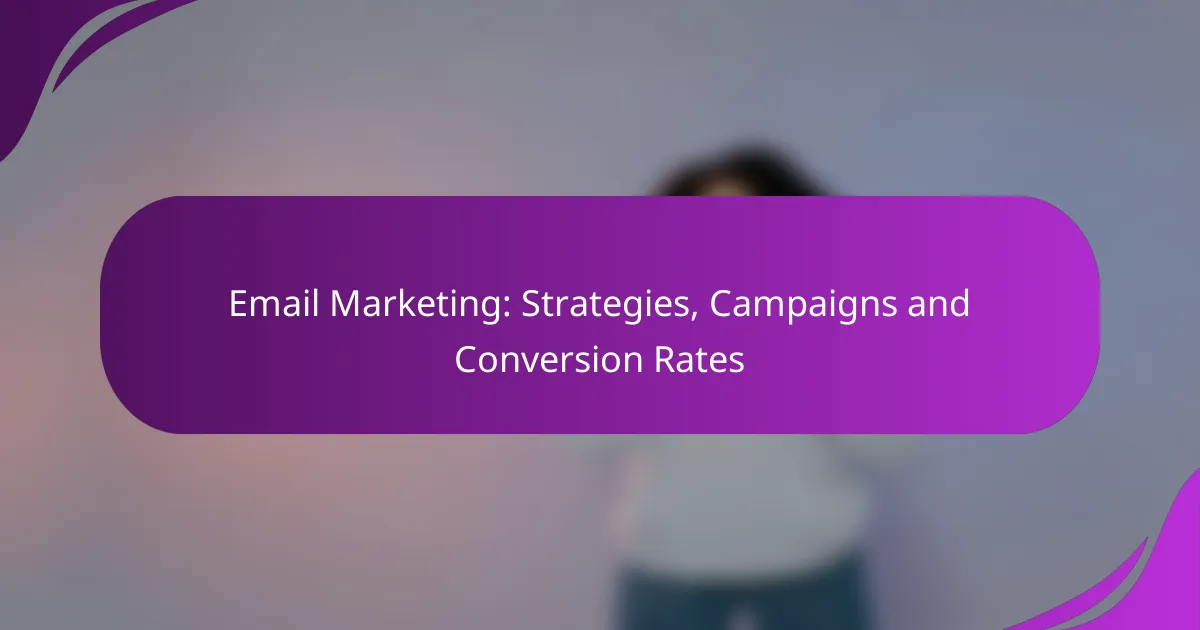Email marketing remains a powerful tool for businesses looking to boost engagement and conversion rates. By focusing on strategies such as personalization, segmentation, and automation, companies can create effective campaigns that resonate with their audience. Additionally, optimizing email elements like subject lines and calls-to-action can further enhance the likelihood of recipients taking desired actions.

What are effective email marketing strategies for UK businesses?
Effective email marketing strategies for UK businesses focus on personalization, segmentation, automation, content optimization, and mobile-friendly designs. These elements help enhance customer engagement and improve conversion rates.
Personalization techniques
Personalization in email marketing involves tailoring messages to individual recipients based on their preferences and behaviors. This can include using the recipient’s name, recommending products based on past purchases, or sending targeted offers based on their browsing history.
To implement personalization effectively, businesses should collect relevant data through sign-up forms and customer interactions. Utilizing dynamic content that changes according to the recipient’s profile can significantly increase engagement rates.
Segmentation best practices
Segmentation involves dividing your email list into smaller groups based on specific criteria such as demographics, purchase history, or engagement levels. This allows businesses to send more relevant content to each group, which can lead to higher open and click-through rates.
Best practices for segmentation include regularly updating your segments based on customer behavior and preferences. Consider using criteria like location, age, or buying patterns to create targeted campaigns that resonate with each segment.
Automated workflows
Automated workflows streamline email marketing by sending messages based on specific triggers, such as a new subscriber joining the list or a customer abandoning their cart. This ensures timely communication and can nurture leads effectively.
To set up automated workflows, identify key customer journeys and define the triggers for each stage. Common workflows include welcome emails, follow-ups after purchases, and re-engagement campaigns for inactive subscribers.
Content optimization
Content optimization focuses on creating compelling and relevant email content that drives action. This includes crafting engaging subject lines, using clear calls to action, and ensuring the content aligns with the recipient’s interests.
To optimize content, businesses should A/B test different elements such as subject lines and email layouts. Analyzing performance metrics can help refine content strategies and improve overall effectiveness.
Mobile-friendly designs
With a significant portion of emails being opened on mobile devices, having a mobile-friendly design is crucial. This means ensuring that emails are responsive and easy to read on smaller screens, with appropriately sized images and buttons.
To create mobile-friendly emails, use a single-column layout, keep text concise, and ensure that links and buttons are easily clickable. Testing emails on various devices before sending can help identify any issues that may hinder user experience.

How can I improve email campaign conversion rates?
Improving email campaign conversion rates involves optimizing various elements of your emails to encourage recipients to take desired actions. Key strategies include clear calls-to-action, effective A/B testing, timing your sends appropriately, and crafting engaging subject lines.
Clear call-to-action placement
Effective call-to-action (CTA) placement is crucial for driving conversions. Position your CTAs prominently within the email, ideally above the fold, so that they are visible without scrolling. Use contrasting colors and concise, action-oriented language to make them stand out.
Consider including multiple CTAs throughout the email, especially in longer messages. This allows recipients to engage with your content at different points, increasing the likelihood of conversion.
A/B testing methods
A/B testing is a powerful method to identify what resonates with your audience. Test different elements such as subject lines, CTA wording, and email layouts to see which versions yield higher conversion rates. Aim for a sample size that provides statistically significant results.
When conducting A/B tests, change only one variable at a time to accurately assess its impact. Analyze the results to refine your approach continuously, focusing on the elements that drive the most engagement and conversions.
Timing and frequency optimization
Finding the right timing and frequency for your email campaigns can significantly affect conversion rates. Analyze your audience’s behavior to determine optimal send times, which may vary based on demographics and time zones. Generally, mid-week mornings tend to see higher engagement.
Be mindful of how often you send emails. Too many emails can lead to subscriber fatigue, while too few may cause your audience to forget about you. A good starting point is to send emails weekly or bi-weekly, adjusting based on engagement metrics.
Engaging subject lines
Crafting engaging subject lines is essential for improving open rates, which directly impacts conversions. Aim for subject lines that are concise, intriguing, and relevant to the content of the email. Personalization, such as including the recipient’s name, can also enhance engagement.
Consider using questions or urgency in your subject lines to prompt action. For example, “Don’t miss out on our exclusive offer!” can create a sense of urgency that encourages recipients to open the email and convert.

What tools can enhance email marketing efforts?
Several tools can significantly enhance email marketing efforts by streamlining processes, improving engagement, and providing valuable insights. Utilizing the right platforms can lead to better campaign performance and higher conversion rates.
Mailchimp features
Mailchimp offers a user-friendly interface with features like customizable templates, audience segmentation, and A/B testing. These tools allow marketers to tailor their campaigns to specific demographics, improving engagement rates.
Additionally, Mailchimp provides robust analytics that track open rates, click-through rates, and other key metrics. This data helps marketers refine their strategies and optimize future campaigns for better results.
HubSpot integrations
HubSpot integrates seamlessly with various applications, enhancing email marketing efforts through CRM capabilities and lead management. This integration allows for personalized email campaigns based on user behavior and interactions.
Moreover, HubSpot’s reporting tools provide insights into campaign performance, enabling marketers to make data-driven decisions. Utilizing these integrations can streamline workflows and improve overall marketing effectiveness.
ActiveCampaign automation
ActiveCampaign excels in automation, allowing marketers to create complex workflows that trigger emails based on user actions. This feature helps in nurturing leads and maintaining engagement without manual intervention.
With tools like conditional content and dynamic segmentation, ActiveCampaign enables highly personalized communication. This level of customization can significantly enhance user experience and increase conversion rates.
Sendinblue analytics
Sendinblue offers comprehensive analytics that track the performance of email campaigns in real-time. Marketers can monitor metrics such as bounce rates, open rates, and conversions, providing a clear picture of campaign effectiveness.
Additionally, Sendinblue’s reporting features allow for easy comparison of different campaigns, helping marketers identify successful strategies. This data-driven approach can guide future campaigns and improve overall marketing ROI.

What metrics should I track for email marketing success?
To gauge email marketing success, focus on key metrics such as open rates, click-through rates, conversion rates, and unsubscribe rates. These indicators provide insights into engagement, effectiveness, and areas for improvement in your campaigns.
Open rates
Open rates measure the percentage of recipients who open your email compared to the total number of emails delivered. A typical open rate can range from 15% to 30%, depending on your industry and audience. To improve this metric, consider crafting compelling subject lines and personalizing your emails.
Keep in mind that open rates can be influenced by factors like the timing of your email and the quality of your mailing list. Regularly segmenting your audience can also help increase open rates by targeting specific groups with relevant content.
Click-through rates
Click-through rates (CTR) indicate the percentage of recipients who clicked on one or more links in your email. A good CTR typically falls between 2% and 5%. To enhance this metric, ensure your calls to action are clear and enticing, and consider using engaging visuals to draw attention.
Testing different layouts and content types can help identify what resonates best with your audience. A/B testing can be particularly effective in optimizing your email campaigns for higher click-through rates.
Conversion rates
Conversion rates reflect the percentage of recipients who complete a desired action, such as making a purchase or signing up for a webinar, after clicking through your email. A healthy conversion rate usually ranges from 1% to 3%. To boost conversions, align your email content with landing page messaging and streamline the user experience.
Incorporating urgency or limited-time offers can also encourage quicker decisions from your audience. Tracking conversions helps you understand the effectiveness of your email campaigns in driving actual business results.
Unsubscribe rates
Unsubscribe rates indicate the percentage of recipients who opt out of your email list after receiving a campaign. A typical unsubscribe rate is around 0.2% to 0.5%. To minimize this rate, ensure your content is relevant and valuable to your audience, and avoid overwhelming them with too many emails.
Providing options for frequency preferences can also help retain subscribers. Regularly cleaning your email list and removing inactive users can improve overall engagement and reduce unsubscribe rates.

What are the prerequisites for a successful email marketing campaign?
Successful email marketing campaigns require a clear strategy, a well-defined target audience, and a quality email list. These elements ensure that your messages reach the right people and encourage engagement, ultimately leading to higher conversion rates.
Building a quality email list
Building a quality email list is essential for effective email marketing. Start by collecting emails through sign-up forms on your website, social media channels, and during events. Ensure that you clearly communicate the value of subscribing, such as exclusive offers or valuable content.
Consider using double opt-in methods to confirm subscribers’ interest, which can enhance list quality and reduce spam complaints. Regularly clean your list by removing inactive subscribers to maintain engagement rates and improve deliverability.
Utilize segmentation to tailor your messages based on subscriber preferences and behaviors. This approach can significantly increase open and click-through rates, as targeted content resonates more with specific audience segments.
